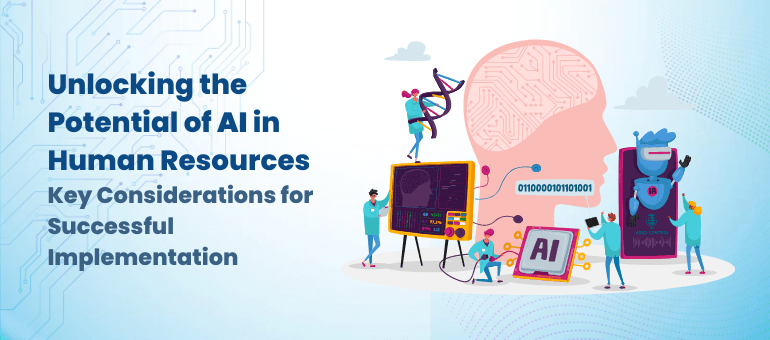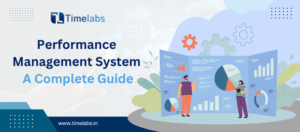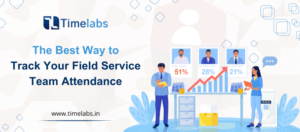In a world where technology is advancing at an unprecedented pace, organizations are turning to Artificial Intelligence (AI) to help them navigate the rapidly changing landscape of human resources. From automating repetitive tasks to making more objective and fair decisions, the potential benefits of AI in HR are clear. But, as with any new technology, implementation can be tricky. To ensure that your organization gets the most out of AI in HR, it’s essential to consider a few factors that we will be discussing in this blog.
Need For AI In Human Resources
Improved Efficiency
AI can automate repetitive and time-consuming tasks, such as candidate screening, resume sorting, and scheduling interviews, which allows HR professionals to focus on more strategic and value-added tasks. For example, AI-powered tools can be used to automatically filter resumes based on specific qualifications, such as education, experience, and skills, which can save HR professionals a significant amount of time.
Moreover, AI can be used in human resource automation to schedule interviews, which can save HR professionals from having to manually coordinate schedules with candidates and hiring managers. By automating these tasks, HR professionals can spend more time on tasks that require more human expertise such as interviews, negotiation, employee development, and retention.
Increased Accuracy
AI can help to eliminate human bias and error, which can lead to more objective and fair decisions. AI-powered tools can be used to assess candidates based on their qualifications and experience, rather than their appearance or other subjective factors. This can help to ensure that the best candidates are selected for open positions, regardless of their race, gender, age, or other characteristics.
AI can also be used to analyze employee engagement data to identify key drivers of engagement and to develop strategies to improve engagement levels. This can help to ensure that employees are engaged and satisfied with their work, which can lead to better retention and productivity.
Better Data Analysis
AI can help to extract insights from large amounts of data, which can be used to improve HR processes and strategies. For example, AI can be used with HRIS to analyze employee engagement data to identify key drivers of engagement and to develop strategies to improve engagement levels. This can help organizations to make data-driven decisions, which can lead to better business outcomes.
Increased Scalability
AI can help organizations to manage a large number of candidates and employees, which can be particularly useful for organizations that are rapidly growing or that operate in multiple locations. Integration of AI in HR software can be used to automatically process resumes, schedule interviews, and conduct initial candidate screenings, which can help organizations efficiently manage a large number of candidates. This can help organizations to scale their HR operations without having to significantly increase their HR staff, which can save organizations a significant amount of money and resources.
5 Ways For Effective HR AI Implementation
Data Quality:
Ensuring that the data used to train and operate the AI is accurate, complete, and relevant to the task at hand is crucial for the success of the implementation. Poor quality data can lead to inaccurate or biased results, which can have serious consequences in the context of human resources. Therefore, it is important to ensure that the data is properly collected, cleaned, and pre-processed before using it to train the AI model for HRMS. Additionally, ensuring that the data is diverse and representative of the population it is intended to serve is also important to avoid bias.
Algorithm Selection:
Choosing the appropriate algorithm(s) based on the specific problem being solved and the nature of the data is critical. For example, decision tree algorithms might be suitable for a problem involving classification, while linear regression algorithms might be more appropriate for a problem involving prediction. Therefore, it is important to have a good understanding of the problem and the data before selecting an algorithm. It is important to keep in mind the explainability and interpretability of the algorithm when making the selection.
Explainability:
Ensuring that the AI system’s decision-making process is transparent and understandable to human stakeholders is critical for building trust in the system and ensuring accountability. When an AI system’s decision-making process is opaque or difficult to understand, it can be difficult for stakeholders to trust the system’s decisions and to identify and correct errors. Therefore, it is important to design AI systems that are explainable, interpretable, and provide a transparent decision-making process.
Human-in-the-loop:
Incorporating human oversight and intervention into the AI system to ensure accountability and prevent errors is essential. This can include incorporating human review of certain decisions, providing the ability for human stakeholders to intervene in the decision-making process, and incorporating human feedback into the AI system’s learning process. This can help to ensure that the AI system is operating as intended and that any errors or biases are identified and corrected.
Continuous Monitoring and Evaluation:
Regularly monitoring and evaluating the AI system’s performance to ensure that it is functioning as intended and making appropriate decisions is crucial. This can include monitoring the system’s performance over time, evaluating the system’s decisions against ground truth data, and conducting user studies to gather feedback from stakeholders. Additionally, it is important to have a robust system for logging and tracking the system’s decisions, so that any errors or issues can be identified and addressed. This can help to ensure that the AI system is continuously improving and providing accurate and fair decisions.
Conclusion
Implementing AI in human resources can be a game-changer for organizations. It can automate tedious tasks, eliminate bias, and provide valuable insights. But, as we’ve seen, it’s not as simple as just incorporating AI into your HR processes. By taking into account the five crucial factors discussed, organizations can pave the way for a smooth and successful implementation of AI in HR. By doing so, they can harness the power of technology to improve the way they attract, retain, and engage talent, ultimately leading to a more efficient and productive workforce, and a more successful organization.



